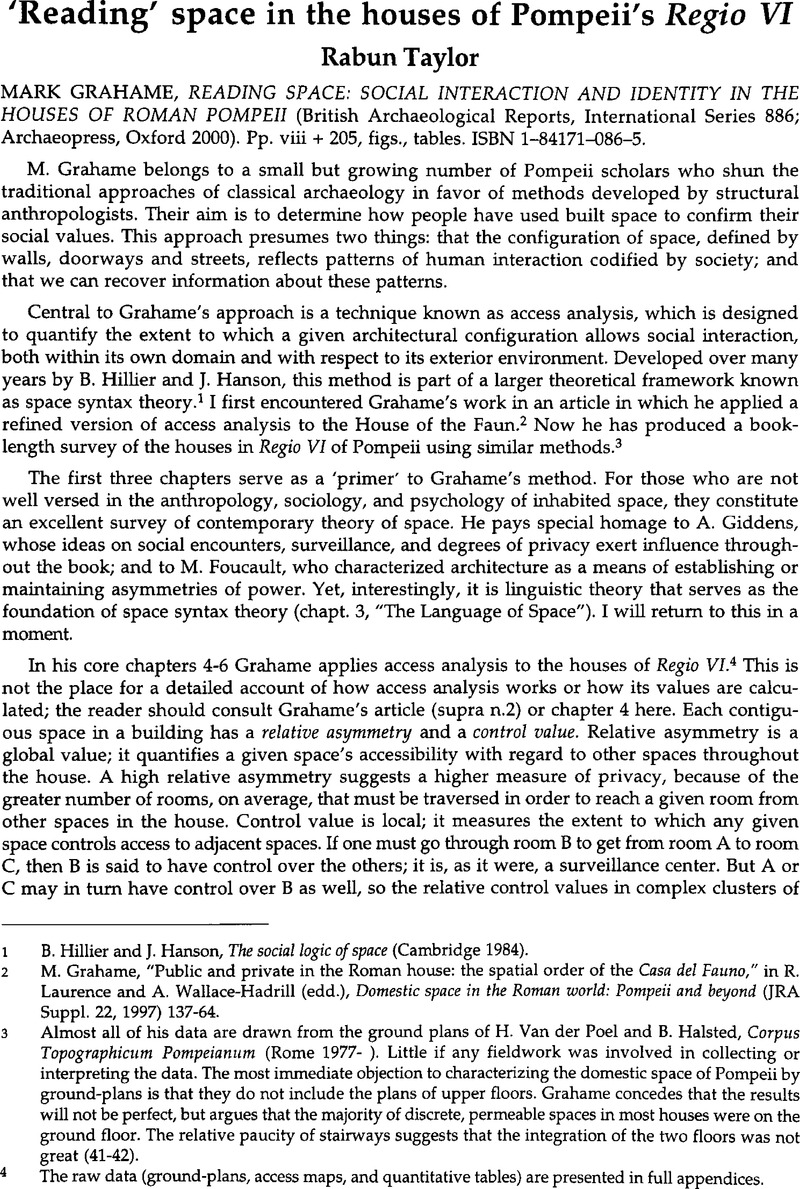Article contents
‘Reading’ space in the houses of Pompeii's Regio VI - Mark Grahame, READING SPACE: SOCIAL INTERACTION AND IDENTITY IN THE HOUSES OF ROMAN POMPEII (British Archaeological Reports, International Series 886; Archaeopress, Oxford 2000). Pp. viii + 205, figs., tables. ISBN 1-84171-086-5.
Review products
Published online by Cambridge University Press: 16 February 2015
Abstract

Information
- Type
- Reviews
- Information
- Copyright
- Copyright © Journal of Roman Archaeology L.L.C. 2002
References
1 Hillier, B. and Hanson, J., The social logic of space (Cambridge 1984)CrossRefGoogle Scholar.
2 Granarne, M., “Public and private in the Roman house: the spatial order of the Casa del Fauno ,” in Laurence, R. and Wallace-Hadrill, A. (edd.), Domestic space in the Roman world: Pompeii and beyond (JRA Suppl. 22, 1997) 137–64Google Scholar.
3 Almost all of his data are drawn from the ground plans of der Poel, H. Van and Halsted, B., Corpus Topographicum Pompeianum (Rome 1977-)Google Scholar. Little if any fieldwork was involved in collecting or interpreting the data. The most immediate objection to characterizing the domestic space of Pompeii by ground-plans is that they do not include the plans of upper floors. Grahame concedes that the results will not be perfect, but argues that the majority of discrete, permeable spaces in most houses were on the ground floor. The relative paucity of stairways suggests that the integration of the two floors was not great (41-42).
4 The raw data (ground-plans, access maps, and quantitative tables) are presented in full appendices.
5 Lévi-Strauss, C., “Introduction à l'oeuvre de Marcel Mauss,” in Mauss, M., Sociologie et anthropologie (Paris 1950) xlix Google Scholar.
6 de Saussure, F., Course in general linguistics (transl. Baskin, W.; New York 1959) 113–14Google Scholar.
7 De Saussure ibid. 122-27. His own analogy is architectural. If one takes a column as the unit in question, its relation to the architrave is syntagmatic. If it is, for example, Doric, then its relationship to the Ionic or Corinthian order is associative.
8 Descombes, V., Objects of all sorts: a philosophical grammar (transl. Scott-Fox, L. and Harding, J.; Baltimore 1986) 172–77Google Scholar.
- 2
- Cited by

